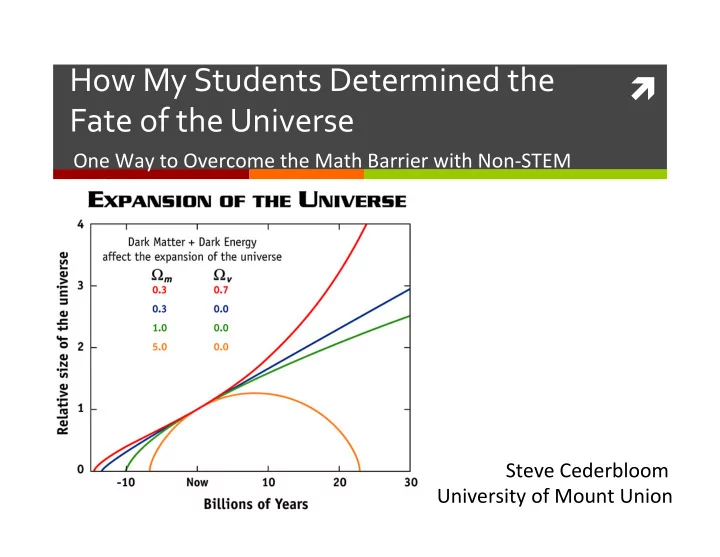

How ¡My ¡Students ¡Determined ¡the ¡ ì ¡ Fate ¡of ¡the ¡Universe ¡ One ¡Way ¡to ¡Overcome ¡the ¡Math ¡Barrier ¡with ¡Non-‑STEM ¡ Majors ¡ ¡ ¡ ¡ ¡ ¡ ¡ ¡ ¡ ¡ ¡ ¡ ¡ ¡ ¡Steve ¡Cederbloom ¡ University ¡of ¡Mount ¡Union ¡
Outline ¡ ì The ¡challenge ¡ ì A ¡framework ¡for ¡meeDng ¡the ¡challenge ¡ ì My ¡soluDon ¡ ì New ¡exploraDons ¡
The ¡challenge ¡ ì A ¡course ¡for ¡the ¡“IntegraDve ¡Core” ¡ – ¡ “Einstein’s ¡Universe: ¡ ¡The ¡Big ¡Bang, ¡Black ¡Holes, ¡and ¡ Beyond” ¡ ì Cosmology ¡is ¡an ¡ observa(onal ¡ science, ¡not ¡an ¡ experimental ¡science ¡ ì How ¡do ¡I ¡get ¡students ¡to ¡DO ¡cosmology? ¡
Authentic ¡science ¡practice ¡in ¡the ¡ classroom ¡ ¡(Edelson, ¡1997) ¡ ì APtudes ¡ ì Tools ¡and ¡techniques ¡ ì Social ¡interacDons ¡
Why ¡is ¡Inquiry ¡Inherently ¡Difficult? ¡ ì “The ¡GePng ¡on ¡Board ¡Problem” ¡(Meyer ¡and ¡Avery, ¡ 2010) ¡ ì ObservaDons ¡generate ¡the ¡need ¡to ¡describe, ¡ organize, ¡and ¡explain ¡ ì The ¡resulDng ¡paradigm ¡suggests ¡new ¡observaDons ¡ to ¡make ¡
Why ¡is ¡Inquiry ¡Inherently ¡Difficult? ¡ ì “The ¡GePng ¡on ¡Board ¡Problem” ¡(Meyer ¡and ¡Avery, ¡ 2010) ¡ Empirical ¡data ¡ TheoreDcal ¡knowledge ¡
Why ¡is ¡Inquiry ¡Inherently ¡Difficult? ¡ ì “The ¡GePng ¡on ¡Board ¡Problem” ¡(Meyer ¡and ¡Avery, ¡ 2010) ¡ ì ObservaDons ¡generate ¡the ¡need ¡to ¡describe, ¡ organize, ¡and ¡explain ¡ ì The ¡resulDng ¡paradigm ¡suggests ¡new ¡observaDons ¡ to ¡make ¡ ì How ¡do ¡you ¡break ¡into ¡this ¡cycle? ¡ ì New ¡Ph.D ¡students ¡start ¡by ¡joining ¡ongoing ¡work ¡of ¡ mentors ¡
A ¡framework ¡for ¡meeting ¡the ¡challenge ¡ ì Choose ¡a ¡topic ¡for ¡the ¡students ¡to ¡explore ¡ ì The ¡expansion ¡of ¡the ¡universe ¡ ì Choose ¡the ¡tools ¡to ¡use ¡ ì Euler’s ¡method ¡ ì Excel ¡ ì Backwards ¡design ¡-‑ ¡scaffolding ¡
Scaffolding ¡ ì Making ¡a ¡graph ¡ ì Using ¡only ¡data ¡at ¡first ¡ ì Using ¡equaDons ¡also ¡ ì EquaDons ¡in ¡Excel ¡ ì Cell ¡addresses ¡ ì Copy ¡and ¡drag ¡ ì SePng ¡up ¡constants ¡ ì Trendlines ¡and ¡slopes ¡
The ¡topic ¡ The ¡universe ¡is ¡ expanding ¡ ¡ The ¡curvature ¡ ¡ is ¡linked ¡to ¡its ¡ history ¡& ¡desDny ¡
The ¡“scale ¡factor” ¡of ¡the ¡Universe, ¡ R , ¡is ¡ governed ¡by ¡the ¡Friedmann ¡equaDon: ¡
SoluDons ¡tell ¡us ¡the ¡possible ¡history ¡ of ¡the ¡Universe ¡ • Depend ¡on ¡amounts ¡of ¡ ma_er, ¡radiaDon, ¡dark ¡ ma_er, ¡& ¡dark ¡energy ¡
The ¡“scale ¡factor” ¡of ¡the ¡Universe, ¡ R , ¡is ¡ governed ¡by ¡the ¡Friedmann ¡equaDon: ¡ ρ ¡changes ¡according ¡ to ¡conservaDon ¡laws ¡
Start ¡with ¡ V ¡and ¡change ¡to ¡slope: ¡ ! 3 ! − ! ! ! ! 1 = ! 8 !" ! ! + ! Λ ! ! 3 ! 2 ρ − kc 2 " % 1 Δ R = 8 π G R 2 + Λ $ ' # R Δ t & 3 3
Euler’s ¡method ¡ Δ R Δ t = R 2 − R 1 t 2 − t 1 1 + Δ R ( ) R 2 = R Δ t t 2 − t 1
Start ¡with ¡“Now” ¡
Type ¡in ¡equations ¡for ¡one ¡time ¡step ¡
The ¡past ¡ ¡
The ¡future ¡and ¡the ¡past ¡
New ¡explorations ¡– ¡two ¡dimensions ¡ ì Can ¡these ¡histories ¡lead ¡the ¡students ¡to ¡new ¡ quesDons? ¡ ¡ ì Are ¡there ¡other ¡quesDons ¡that ¡students ¡could ¡ invesDgate ¡with ¡these ¡tools ¡and ¡techniques? ¡
Embedding ¡diagrams ¡
References ¡ ì Edelson, ¡Daniel ¡C. ¡(1997). ¡ ¡Realising ¡AuthenDc ¡ Science ¡Learning ¡Through ¡the ¡AdapDon ¡of ¡ SciencDfic ¡PracDce . ¡ ¡ In ¡K. ¡Tobin ¡& ¡B. ¡Fraser ¡(Eds.), ¡ ¡ Interna(onal ¡Handbook ¡of ¡Science ¡Educa(on . ¡ Kluwer, ¡Dordrecht, ¡NL. ¡ ¡ ì Meyer, ¡Daniel ¡Z. ¡& ¡Avery, ¡Leanne ¡M. ¡(2010). ¡ ¡Why ¡ Inquiry ¡is ¡Inherently ¡Difficult…and ¡Some ¡Ways ¡to ¡ Make ¡it ¡Easier. ¡ Science ¡Educator, ¡19(1 ), ¡ ¡26-‑32. ¡
Recommend
More recommend